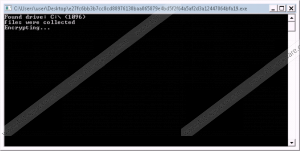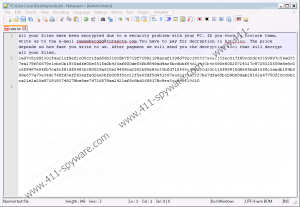Desucrypt Ransomware Removal Guide
If you have let Desucrypt Ransomware into your Windows operating system, it is almost a guarantee that your personal files were corrupted. This malicious threat does not avoid photos, documents, PDFs, music and videos files, shortcuts, and other kinds of data. All files – except for system files – are encrypted by this monstrous infection, and that is done so that the creator of this infection could demand a ransom payment from you. If your files are important to you, you might choose to follow the demands of cyber criminals, but, of course, that is not something we recommend doing. What could happen if you paid the ransom? Most likely, you would not get anything that would help with the decryption of files, and that is the only reason why you would pay it in the first place. The good news is that a free decryptor allegedly created by @demonslay335 on Twitter exists. Hopefully, you can use it to recover your files, right after which, you must delete Desucrypt Ransomware.
How did Desucrypt Ransomware enter your operating system? Since it slithers in silently, you might have no idea about this, and that is not good because that means that you will probably be unable to remove this infection manually. If you have executed it by downloading a spam email attachment, you might be able to find it in %USERPROFILE%\Desktop, %USERPROFILE%\Downloads, %TEMP%, or another directory where downloaded files are often placed. The name of the launcher is random, and so we cannot help you identify it. While the launcher might be hard to recognize and remove, you will have no trouble with that when it comes to “note.txt.” This is the file that the creator of Desucrypt Ransomware wants you to find right after the encryption is complete. The purpose of this file is to inform you that you can obtain a file decryptor if you email rememberggg@tutanota.com and then pay the ransom. It is unknown what the price of the ransom is or how you should pay it, but you would definitely get this information if you emailed cyber criminals. That being said, you should not do this because they could expose you to more threats. Furthermore, you would not get a decryptor anyway regardless of what you did.
If you rely on backups to recover your files, they must be external. Desucrypt Ransomware uses the “cmd.exe / c vssadmin delete shadows / all / quiet & wmic shadowcopy delete & bcdedit / set{ default } bootstatuspolicy ignoreallfailures & bcdedit / set{ default } recoveryenabled no & wbadmin delete catalog – quiet” command to delete the backup catalog and shadow copies, as well as to disable the Windows Error Recovery. By doing this, the ransomware ensures that you cannot recover the files that have the “.[rememberggg@tutanota.com].DEUSCRYPT” extension attached to their names. In fact, if a decryptor was not created by a third-party, it would be impossible for you to recover your personal files. In most cases, that is what the victims of ransomware have to deal with. Did you know that there are tons of ransomware threats out there? Velso Ransomware, Lime Ransomware, Krypton Ransomware, and many others are waiting for their opportunity to strike, and that is why protecting your system is crucial.
Are you prepared to tackle Desucrypt Ransomware? You need to figure out how to clean your entire operating system first. We suggest employing anti-malware software to take care of the overall security issue as well. As long as this software is installed, you will not need to worry about other threats or their removal. Hopefully, your files are restored by now, but even if they are not, you must remove Desucrypt Ransomware from your operating system. Do not be mistaken by the guide below. Although only a few steps are required to get rid of this malware, these steps can be too complicated for you to perform. The most important step, of course, is to delete the launcher file, and since it has a random name and might be placed anywhere on your system, we cannot guarantee that you will be able to eliminate it yourself.
How to delete Desucrypt Ransomware
- Identify the {unknown launcher file name}.exe.
- Right-click and Delete the ransomware file.
- Right-click and Delete the ransom note file, note.txt.
- Empty Recycle Bin to eliminate these components.
- Perform a full system scan to check if your system is clean.
Desucrypt Ransomware Screenshots:


Desucrypt Ransomware technical info for manual removal:
Files Modified/Created on the system:
| # | File Name | File Size (Bytes) | File Hash |
|---|---|---|---|
| 1 | e27fc6bb3b7cc8cd88976130baa065879e4bd5f2f64a5af2d3a12447064bfa19.exe | 265728 bytes | MD5: c80ea6a8b0c010aed7248d0ae3d1c7ac |
Memory Processes Created:
| # | Process Name | Process Filename | Main module size |
|---|---|---|---|
| 1 | e27fc6bb3b7cc8cd88976130baa065879e4bd5f2f64a5af2d3a12447064bfa19.exe | e27fc6bb3b7cc8cd88976130baa065879e4bd5f2f64a5af2d3a12447064bfa19.exe | 265728 bytes |

